Introduction: Why Staying Relevant in Tech Matters in 2026
Most Valuable Tech Skills in 2026 are reshaping how professionals grow and how companies hire. In a world where technology evolves faster than ever, the job market is being transformed by automation, generative AI, and cloud-native systems. Employers aren’t just looking for coders—they want problem solvers, automation experts, and product-savvy engineers.
And there’s more: A new programming language called Mojo is taking the developer world by storm. Built as a superset of Python, Mojo blends AI optimization with low-level speed—making it one of the most talked-about tools for 2026.
In this article, we break down the 10 most valuable tech skills for 2026, including the tools to learn, job titles to aim for, and learning resources to get you started.
Table of Contents
1. AI Engineering & LLM Integration
Why It Matters: AI is now embedded in products, workflows, and tools. Companies need devs who can build with OpenAI, not just use ChatGPT.
Key Tools: Python, PyTorch, LangChain, LlamaIndex, Pinecone, RAG pipelines
Careers: AI Solutions Architect, Prompt Engineer
Quick Tip: Start with LangChainHub templates to speed up prototyping.
2. Cybersecurity & Offensive Hacking
Why It Matters: As remote work grows, so does the attack surface. Trust and compliance are mission-critical.
Key Tools: OWASP, Burp Suite, Wireshark, Metasploit, Python for scripting
Careers: Security Engineer, Red Team Analyst
Example: Ethical hackers helped uncover API flaws in major fintech apps in 2025—saving millions in data breaches.
3. Cloud Native Development & DevOps
Why It Matters: DevOps is no longer optional—it’s expected. Companies want developers who can ship, scale, and monitor.
Key Tools: Docker, Kubernetes, Terraform, GitHub Actions, Prometheus, Grafana
Careers: DevOps Engineer, SRE, Platform Engineer
Quick Tip: Helm makes Kubernetes more manageable. Learn it early.
4. Data Engineering & ETL Pipelines
Why It Matters: Every product decision is data-driven. Clean pipelines mean reliable insights.
Key Tools: SQL, Apache Airflow, dbt, Kafka, Snowflake, Redshift
Careers: Data Engineer, Analytics Engineer
Example: Spotify scaled its real-time analytics by adopting event-driven ETL with Kafka and dbt.

5. Web3 & Smart Contract Development
Why It Matters: Web3 isn’t dead. DeFi, NFTs, and DAOs still fuel innovation in finance and gaming.
Key Tools: Solidity, Rust, Foundry, Chainlink, The Graph
Careers: Blockchain Developer, Solidity Engineer
Quick Tip: Test contracts with Hardhat and get involved in hackathons.
6. Edge & Embedded Systems
Why It Matters: From smart homes to industrial IoT, edge computing powers devices where cloud latency is too slow.
Key Tools: C, Rust, MicroPython, TinyML, ESP32, WebAssembly
Careers: Embedded Systems Engineer, IoT Developer
Example: Tesla’s self-driving unit optimized ML models directly on embedded chips to reduce power usage.
7. AR/VR & Spatial Computing
Why It Matters: Apple Vision Pro and Meta Quest 4 mark the next era of immersive tech.
Key Tools: Unity, C#, ARKit, RealityKit, Blender, WebXR
Careers: XR Developer, Spatial UX Designer
Quick Tip: Use Unity Asset Store for prototyping environments quickly.
8. APIs & Automation Engineering
Why It Matters: 2026 is about stitching together APIs and workflows—not reinventing the wheel.
Key Tools: REST, GraphQL, Zapier, Make.com, CRON, Discord API
Careers: Automation Engineer, Workflow Dev, Indie Hacker
Example: Startups like Tally automate 70% of backend work using no-code APIs.
Ready to Automate Your Career?
Explore high-impact jobs in AI and automation—no-code, low-code, and full-stack roles are all hiring.
Check Out Automation + AI Jobs →9. Fullstack Development with Modern JavaScript
Why It Matters: The stack has evolved—modern fullstack is fast, reactive, and AI-integrated.
Key Tools: React, Svelte, TypeScript, tRPC, Supabase, OpenAI API
Careers: Fullstack Developer, Tech Cofounder
Quick Tip: Use serverless functions for backend logic tied to AI responses.
10. Product Thinking + UX for Engineers
Why It Matters: It’s not just about code—it’s about solving real user problems.
Key Tools: Figma, Whimsical, Notion, SEO, Copywriting
Careers: Technical PM, UX-Aware Engineer
Quick Tip: Build–Measure–Learn cycles help validate features before scaling.
Bonus: Emerging Skill Stacks That Pay Well
Combine tools for niche, high-value skill stacks:
- AI Stack: Python + LangChain + OpenAI + Pinecone
- Cloud/Data Stack: SQL + dbt + Airflow + BigQuery
- Automation Stack: Python + APIs + Zapier + GitHub Actions
- Web3 Stack: Solidity + Foundry + The Graph
Freelancers and indie hackers with these mixes earn $80–150/hr on platforms like Toptal and Upwork.
Best Learning Resources (Free & Beginner-Friendly)
- LangChainHub – Templates for LLM-powered apps
- Prompt Engineering Guide – Free on GitHub
- Data Engineering Zoomcamp – ETL training from the ground up
- Docker Curriculum – Learn containers and DevOps basics
- OSSU CS Path – Complete computer science roadmap
What to Learn First?
If you’re a beginner: Start with Python + Git + APIs + basic automation
If you’re switching careers: Data Engineering or Fullstack JS offers fast ROI
If you’re already in tech: Level up in AI, Cloud, or Cybersecurity
💡 Rule of thumb: Follow where innovation meets hiring demand.
FAQs
What tech skill will be most in demand in 2026?
AI engineering and automation top the list.
Is AI going to replace developers?
No—but developers who use AI will replace those who don’t.
How do I start learning cybersecurity?
Start with OWASP Top 10, then practice with Hack The Box.
Which tech jobs pay the most in 2026?
AI Architects, Security Engineers, and Data Engineers lead with $150K+ salaries.
Is Web3 still relevant?
Yes—especially in DeFi, DAOs, and blockchain infrastructure.
Conclusion
2026 is the year of specialization + versatility. Whether you’re breaking into tech or doubling down, now’s the time to focus on future-proof skills that blend code with creativity, product thinking, and automation.
Start learning one of these tech skills today—your 2026 self will thank you.




